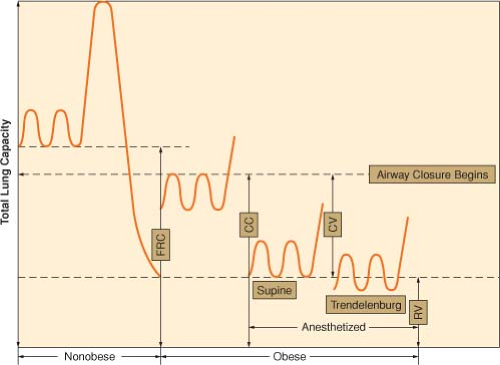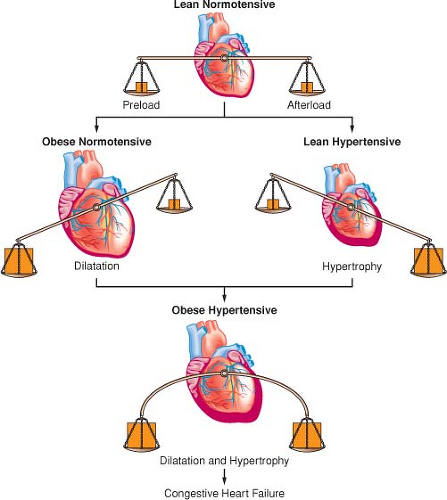Anesthesia and Obesity
The World Health Organization defines obesity as a condition with excess body fat to the extent that health and well-being are adversely affected (Bucklin BA, Fernandez-Bustamante A. Anesthesia and obesity. In: Barash PG, Cullen BF, Stoelting RK, Cahalan MK, Ortega R, Stock MC, eds. Clinical Anesthesia. Philadelphia: Lippincott Williams & Wilkins; 2013:1274–1293). About one-third of Americans (33.8%) are currently obese. The prevalence of obesity in the United States is unevenly distributed geographically, by race and ethnicity, and by socioeconomic status.
I. Definition and Epidemiology
Obesity-related conditions, including cardiovascular accidents, insulin- and non–insulin-dependent diabetes, and some types of cancer, are leading causes of death in this population.
The definition of obesity includes the presence of excessive body weight for the patient’s age, gender, and height (Body mass index [BMI] = Weight/[Height]2) (Table 44-1).
The anatomic distribution of body fat has associated pathophysiologic implications.
Android (central) obesity is when the adipose tissue is located predominantly in the upper body (truncal distribution) and is associated with increased oxygen consumption and an increased incidence of cardiovascular disease. Visceral fat is particularly associated with cardiovascular disease and left ventricular dysfunction.
Gynecoid (peripheral) obesity is when the adipose tissue is located predominantly in the hips, buttocks, and thighs. This fat is less metabolically active, so it is less closely associated with cardiovascular disease.
Waist circumference correlates with abdominal fat and is an independent risk predictor of disease.
II. Management of Obesity
Medical Therapy. The indications for pharmacologic treatment include a BMI ≥30 kg/m2 or a BMI between 27 and
29.9 kg/m2 in conjunction with an obesity-related medical complication.
Lifestyle counseling is still the most effective tool for long-term weight loss, but it can be combined with the use of medications.
Currently, the only antiobesity medications approved by the US Food and Drug Administration are phentermine and Orlistat. Chronic use of Orlistat may result in fat-soluble vitamin deficiency. A prolonged prothrombin time with a normal partial thromboplastin time during Orlistat treatment may reflect vitamin K deficiency; this coagulopathy should be corrected 6 to 24 hours before elective surgery.
A variety of over-the-counter preparations, plant extracts, and herbs are often used by patients to combat obesity. The American Society of Anesthesiologists (ASA) warns patients to tell their anesthesiologists about medications they are taking, including vitamins, herbs, and other supplements because these products may interfere with anesthesia or cause complications during surgery.
Surgical Therapy (Bariatric Surgery). Bariatric surgery is currently the most effective treatment for morbid (class III) obesity (BMI >40 kg/m2 or BMI >35 kg/m2 or patients with
obesity-related comorbidities not controlled with medical therapy).
Restrictive procedures include vertical-banded gastroplasty and adjustable gastric banding.
Combined procedures include Roux-en-Y gastric bypass (RYGB), which combines gastric restriction with a minimal degree of malabsorption.
RYGB gastric bypass, adjustable gastric banding, and vertical-banded gastroplasty can all be performed laparoscopically. Laparoscopic bariatric surgery is associated with less postoperative pain, lower morbidity, faster recovery, and less “third spacing” of fluid.
Table 44-1 Classification of Obesity and Systemic Disease Risk According to Waist Circumference | |||||||||||||||||||||||||||||||||||||||||||||||
|---|---|---|---|---|---|---|---|---|---|---|---|---|---|---|---|---|---|---|---|---|---|---|---|---|---|---|---|---|---|---|---|---|---|---|---|---|---|---|---|---|---|---|---|---|---|---|---|
| |||||||||||||||||||||||||||||||||||||||||||||||
III. Pathophysiology
Obesity can have an adverse effect on multiple organ systems (Table 44-2).
Respiratory System (Fig. 44-1). Obese patients often have obstructive sleep apnea (OSA) characterized by periodic, partial, or complete obstruction of the upper airway during sleep. The “gold standard” diagnostic test for OSA is overnight polysomnography (OPS). The inconvenience, time,
and expense of OPS leads to an unknown fraction of obese patients with suspicious but no formal diagnosis of OSA.
Suggestive signs to look for during the preoperative visit include witnessed episodes of apnea during sleep, BMI ≥35 kg/m2, neck circumference ≥40 cm, hyperinsulinemia, and elevated glycosylated hemoglobin.
Symptoms of snoring, frequent arousals during sleep and daytime sleepiness, impaired concentration, memory problems, and morning headaches are common but not predictive.
A thorough preoperative evaluation for possible OSA is recommended before elective surgery to allow preparation of a perioperative management plan. Preoperative initiation of continuous positive airway pressure (CPAP), especially in severe OSA cases, should be considered. Patients with confirmed or suspected OSA are at high risk of presenting with a difficult airway and postoperative pulmonary complications (exquisite sensitivity to respiratory depressant effects of opioids as used for postoperative pain management) (Table 44-3).
Cardiovascular and Hematologic Systems. Cardiac output increases with increasing weight by as much as 20 to 30 mL/kg of excess body fat because of ventricular dilation and increases in stroke volume. When left ventricular wall thickening fails to keep pace with dilation, systolic dysfunction (“obesity cardiomyopathy”) and eventual biventricular failure result (Figs. 44-2 and 44-3).
Symptoms such as angina or exertional dyspnea occur only occasionally because morbidly obese patients often have very limited mobility and may appear asymptomatic even when they have significant cardiovascular disease.
Blood flow to fat is 2 to 3 mL/100 g of tissue. An excess of fat requires an increase in cardiac output to parallel an increase in oxygen consumption.
Gastrointestinal System
The combination of hiatal hernia, gastroesophageal reflux, and delayed gastric emptying, coupled with increased intra-abdominal pressure and high-volume and low-pH gastric content, puts obese patients at risk for an increased incidence of severe pneumonitis if aspiration occurs.
Unpremedicated, nondiabetic fasting obese surgical patients who are free from significant gastroesophageal pathology are unlikely to have high-volume, low-pH gastric contents after routine preoperative fasting. They should follow the same fasting guidelines as nonobese patients and be allowed to drink clear liquids up until 2 hours before elective surgery.
Morbidly obese patients who have undergone intestinal bypass surgery have a particularly high prevalence of hepatic dysfunction and cholelithiasis.
Renal and Endocrine Systems
Impaired glucose tolerance in morbidly obese people is reflected by a high prevalence of type II diabetes mellitus
as a result of resistance of peripheral adipose tissue to insulin. Hyperglycemia, insulin resistance, and diabetes predispose obese patients to wound infections and an increased risk of myocardial infarction.
Exogenous insulin may be required perioperatively even in obese patients with type II diabetes mellitus to oppose the catabolic response to surgery.
Metabolic Syndrome (Table 44-4)
 Figure 44-1. Effects of obesity, positioning, and anesthesia on lung volumes. CC = closing capacity; CV = closing volume; FRC = functional residual capacity; RV = residual volume. |
 Figure 44-3. Adaptation of the heart to obesity and hypertension. (Reprinted from Messerli FH. Cardiovascular effects of obesity and hypertension.) |
Table 44-2 Anesthetic Implications of Obesity | |||||||
|---|---|---|---|---|---|---|---|
|









